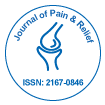The Role of Pain Modulation in Effective Management
Received: 01-Jan-2025 / Manuscript No. jpar-25-163056 / Editor assigned: 03-Jan-2025 / PreQC No. jpar-25-163056(PQ) / Reviewed: 17-Jan-2025 / QC No. jpar-25-163056 / Revised: 22-Jan-2025 / Manuscript No. jpar-25-163056(R) / Published Date: 29-Jan-2025
Abstract
Pain modulation refers to the processes by which the perception of pain is altered by various factors, including psychological, physiological, and environmental influences. This article explores the mechanisms of pain modulation, including the roles of the central and peripheral nervous systems, and discusses various therapeutic approaches aimed at enhancing pain relief. Techniques such as pharmacological interventions, cognitive-behavioral therapy, and complementary therapies are examined for their effectiveness in modulating pain perception. Understanding the complexities of pain modulation can lead to more effective pain management strategies, ultimately improving patient outcomes and quality of life.
Keywords
Pain modulation; Pain perception; Central nervous system; Peripheral nervous system; Pharmacological interventions; Cognitive-behavioral therapy; Complementary therapies; Pain management; Neuroplasticity; Chronic pain
Introduction
Pain is a complex and subjective experience that serves as a protective mechanism for the body. However, when pain becomes chronic, it can lead to significant physical and emotional distress. Pain modulation refers to the various processes that influence the perception of pain, allowing for alterations in pain intensity and quality. These processes can be influenced by a range of factors, including psychological states, previous experiences, and environmental contexts. Understanding the mechanisms of pain modulation is crucial for developing effective pain management strategies that can enhance patient outcomes [1,2].
Description
Pain modulation occurs through various mechanisms involving both the central and peripheral nervous systems. The central nervous system (CNS) plays a pivotal role in processing pain signals and can either amplify or dampen pain perception. Neurotransmitters such as endorphins, serotonin, and norepinephrine are involved in the modulation of pain at the spinal cord and brain levels. Additionally, the peripheral nervous system can influence pain through nociceptive pathways that transmit pain signals from the site of injury to the CNS [3].
Several therapeutic approaches have been developed to enhance pain modulation. Pharmacological interventions, including nonsteroidal anti-inflammatory drugs (NSAIDs), opioids, and adjuvant medications, aim to alter pain perception by targeting specific pathways in the nervous system. Cognitive-behavioral therapy (CBT) focuses on changing negative thought patterns and behaviors associated with pain, thereby reducing its perceived intensity. Complementary therapies, such as acupuncture and mindfulness meditation, have also shown promise in modulating pain perception through various physiological and psychological mechanisms [4].
Discussion
The effectiveness of pain modulation techniques varies among individuals, influenced by factors such as genetics, psychological state, and the nature of the pain condition. Research has shown that a multidisciplinary approach to pain management, which combines pharmacological and non-pharmacological interventions, can lead to better outcomes. For instance, patients who engage in CBT alongside medication often report lower pain levels and improved coping strategies. Additionally, emerging research on neuroplasticity suggests that the brain's ability to adapt and reorganize itself can be harnessed to improve pain modulation, offering new avenues for treatment [6].
Despite the advancements in understanding pain modulation, challenges remain in clinical practice. The subjective nature of pain makes it difficult to assess and treat effectively. Furthermore, the risk of opioid dependence and the side effects of certain medications necessitate a careful and balanced approach to pain management. Continued research into the mechanisms of pain modulation and the development of innovative therapies will be essential for improving pain management strategies [7].
Conclusion
Pain modulation is a complex interplay of physiological, psychological, and environmental factors that influence the perception of pain. By understanding the mechanisms involved in pain modulation, healthcare providers can develop more effective and personalized pain management strategies. A multidisciplinary approach that incorporates pharmacological treatments, cognitive-behavioral therapy, and complementary therapies can enhance pain relief and improve patient quality of life. As research continues to evolve, new insights into pain modulation will pave the way for innovative therapies, ultimately leading to better outcomes for individuals suffering from acute and chronic pain.
References
- Mavragani IV, Nikitaki Z, Kalospyros SA, Georgakilas GA (2019) Ionizing Radiation and Complex DNA Damage: From Prediction to Detection Challenges and Biological Significance. Cancers 11: 1789.
- Apetoh L, Ghiringhelli F, Tesniere A, Criollo A, Ortiz C, et.al (2007) The Interaction Between HMGB1 and TLR4 Dictates the Outcome of Anticancer Chemotherapy and Radiotherapy. Immunol Rev 220: 47-59.
- Fucikova J, Kepp O, Kasikova L, Petroni G, Yamazaki T, et.al (2020) Detection of Immunogenic Cell Death and Its Relevance for Cancer Therapy. Cell Death Dis 11: 1013.
- Burnette BC, Liang H, Lee Y, Chlewicki L, Khodarev NN, et.al (2011) The Efficacy of Radiotherapy Relies upon Induction of Type I Interferon-Dependent Innate and Adaptive Immunity. Cancer Res 71: 2488-2496
- Jarand J,Levin A,Zhang L,Huitt G,Mitchell JD,et al. (2011) Clinical and microbiologic outcomes in patients receiving treatment for Mycobacterium abscessus pulmonary disease. Clin Infect Dis 52: 565-571.
- Wu Q, Li J, Zhu S, Wu J, Chen C, et al. (2017) Breast Cancer Subtypes Predict the Preferential Site of Distant Metastases: A SEER Based Study. Oncotarget 8: 27990-27996.
- Yoneyama K, Nakagawa M, Hara A (2018) Bladder Metastasis from Primary Breast Cancer: A Case Report. Surg Case Rep 4: 73.
Indexed at, Google Scholar, Crossref
Indexed at, Google Scholar, Crossref
Indexed at, Google scholar , Crossref
Indexed at, Google Scholar, Crossref
Indexed at, Google Scholar, Crossref
Indexed at, Google Scholar, Crossref
Citation: Ana N (2025) The Role of Pain Modulation in Effective Management. J Pain Relief 14: 706.
Copyright: © 2025 Ana N. This is an open-access article distributed under the terms of the Creative Commons Attribution License, which permits unrestricted use, distribution, and reproduction in any medium, provided the original author and source are credited.
Share This Article
Recommended Conferences
42nd Global Conference on Nursing Care & Patient Safety
Toronto, CanadaRecommended Journals
Open Access Journals
Article Usage
- Total views: 50
- [From(publication date): 0-0 - Apr 28, 2025]
- Breakdown by view type
- HTML page views: 32
- PDF downloads: 18
